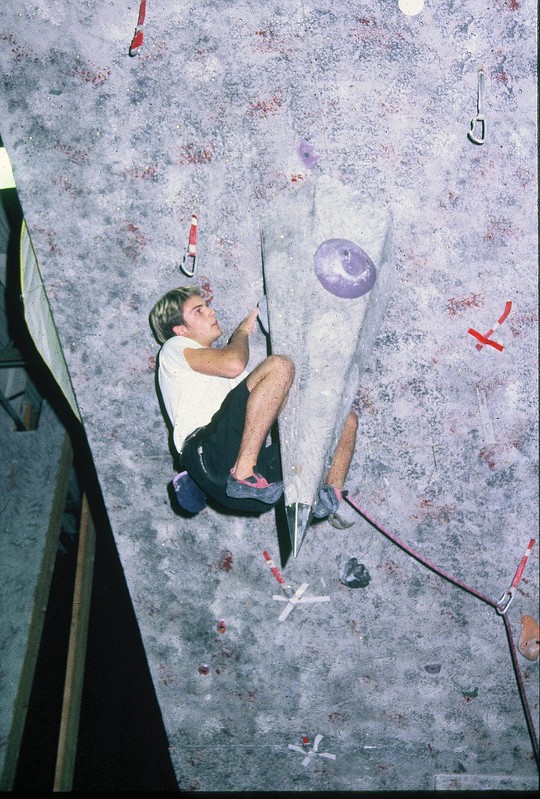Alan Watts is responsible for the massive success of sport climbing in the United States. Today, in almost every area of the country, sport climbing has helped introduce people to the activity who may never have had the chance. With the addition of preplaced bolts, the barrier to getting into rock climbing is the easiest it’s ever been.
Before sport climbing, traditional (trad) climbing was the way rocks were conquered. It was a daring adventure involving scaling a rock face and strategically placing removable protection in its weak points, like cracks and seams. The challenge was that there was still so much uncharted rock waiting to be conquered, yet it couldn’t be done with traditional gear. And then, sport climbing emerged, a new frontier of exploration and innovation.

Alan Watts
Alan Watts, the grandfather of sport climbing, first started visiting Smith Rock in Oregon, as he’d like to say before he was born. Technically, he did! He has a photo of his pregnant mother in this legendary area.
Like everywhere else around the country, Smith Rock was a hub of traditional climbing. In the early 80s, Watts, a passionate climber, scaled every route at Smith Rock. After conquering every two hundred or so routes, he faced a decision: repeat them all or forge his own path. This was a pivotal moment in the climbing community, a testament to the shared passion and the spirit of innovation that defined sport climbing.
Since every possible trad climb was established, Watts started looking for ways up the rock between the cracks. He wasn’t looking for the easily accessible routes but the more challenging stuff he could do. Before, any preplaced bolts on a route were done from the ground up while the climber was on the rock. That inhibited the development of the more challenging routes, capping the climbing difficulty.
This is how sport climbing in the United States started.
Watts, a true pioneer, decided to find a section of rock that could be climbed, rappel down it, and drill bolts into the wall. This new style of developing routes, known as ‘bolting,’ was initially seen as a stain on the climbing world. Traditionalists disagreed with Watts’ climbing ethics and thought there should be one way to climb: their way. However, Watts’ innovative approach opened up a whole new world of climbing possibilities, paving the way for the sport climbing we know today.
International Popularity
1985 Alan Watts and Smith Rock became so popular that it became an international climbing destination. Mike Volk, a photographer and friend of Watts, had photos published in Europe showing Alan on a sport route at Smith Rock.
Alan didn’t know then that while he was changing the climbing scene in the United States, others in Europe were doing the same thing. European climbers such as Wolfgang Güllich, brothers Marc Le Menestrel and Antoine Le Menestrel, and U.K. climbers outcasted by the traditionalists in their home country, Ben Moon and Jerry Moffatt, were part of the new wave of rock climbing. Sport climbing was growing quickly, and climbers were sending more complex routes.
How Sport Climbing Changed Climbing Forever
Sport climbing introduced the revolutionary concept of ‘redpointing.’ Redpointing is leading a route after having practiced the moves on top rope. This technique allowed climbers to strategize and perfect their moves, without the fear of falling. It was a game-changer, a testament to the continuous growth and development in the sport, inspiring climbers to push their limits and reach new heights.
With the introduction of sport climbing came climbing gyms, which revolutionized the sport. These gyms not only provided a safe and controlled environment for climbers to practice, but they also brought competition climbing to the forefront. Climbing gyms allowed those without prior rock climbing experience to learn and develop their knowledge. There was no more extensive barrier to enjoying rock climbing. You can now find a climbing gym in almost every major city in the U.S., and often, more than one, a testament to the popularity and accessibility of the sport.
Competition climbing has moved from competitive climbing on rocks at a crag to debuting in the 2020 Tokyo Olympics. This global recognition of the sport is a testament to its popularity and the incredible strength and technique of rock climbers. The International Federation of Sport Climbing (IFSC) has also created a place for climbers to compete in each discipline: lead, boulder, and speed, further solidifying the sport’s place on the international stage.
Thank you, Alan.
Thanks to one man, the history of rock climbing in the United States changed forever. The grades have skyrocketed since the early 80s, proving how hard humans can climb. To see how far climbing has come from the days of Alan Watts rappelling and bolting lines solo, look for the climbing events during the 2024 Paris Olympics.

Recent Comments